- You are here:
- Home »
- Drills/Exercises
Category Archives for Drills/Exercises
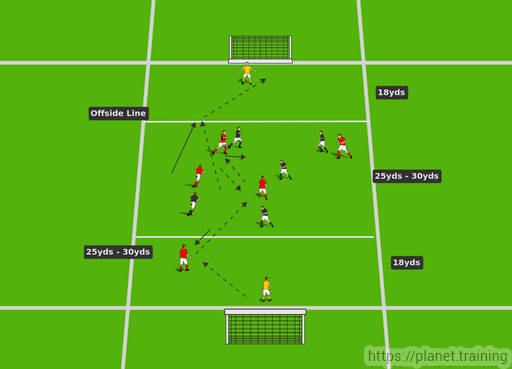
In and Out Possession
By Sean Reed –
Objective
For this session we are focusing keeping possession in a 4v4 + 3 neutral players.
Set Up
1. 2 teams of 4 players + 3 Neutral players
2. The area between 10-15 x 10-15yds (dependent on level, challenges)
3. Team (Yellow bibs) in possession remain on the outside of the area
4. 2 players from Neutral Team (Black bibs) at either end
5. 1 player from Neutral Team (Black bibs) is the spare player in the middle area
6. Team (Red bibs) is the defending team who remain in the middle
See Diagram 1
7. If the team (red bibs) can win possession, force a mistake, get the ball out of the area they switch to the outside and the team (yellow bibs) go in to defend
8. The team in possession are unlimited touches
9. The neutral players are on 2 touch
10. See Diagram 2
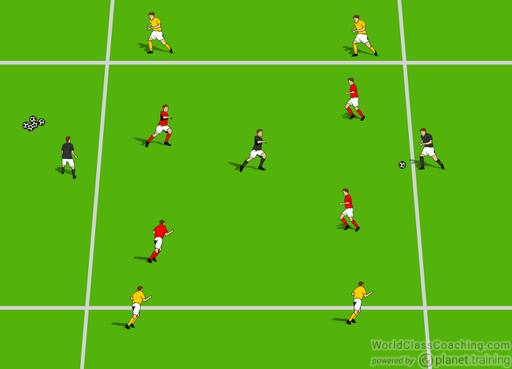
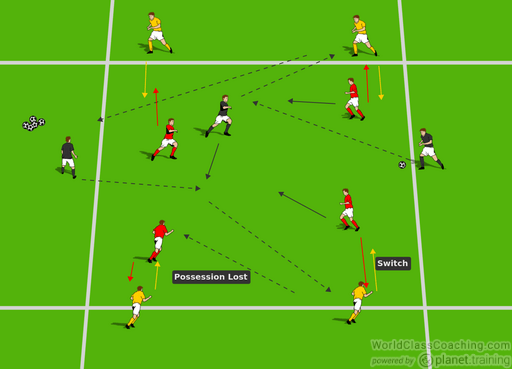
Constraints
• To score a specific number of passes must be made
• To score a goal all 4 yellow players must touch the ball
• Team in possession on the outside can not pass to each other
• Team in possession on the outside can not pass to the same shirt next to them
• Change the size of area to challenge
• Limit touches for all
Some Coaching Points –
1. Angle of support
2. Movement to receive the ball
3. Tempo of play
4. Playing a pass safe side
5. Body shape when receiving the ball
6. Transition from in to out and out to in
By Sean Reed
Former First Team Coach of Championship team Fulham FC. Sean is a UEFA A Coach with a Masters in Sport Coaching. He has over 15 years of experience working in professional football from Academy through to First team in the Premiership and Championship.
Web – www.seanjreed.com
Twitter – @SeanJReed
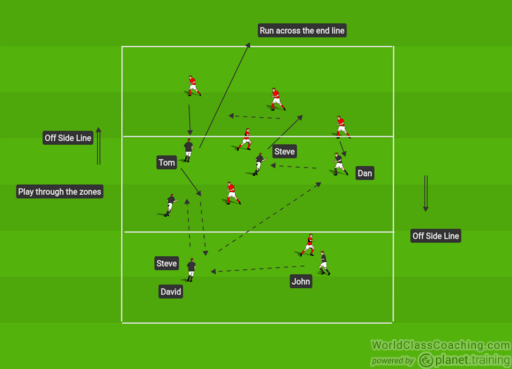
The Name Game
By Sean Reed –
Objective
This session can be included within the warm-up, as an engagement exercise focusing on movement, awareness and communication. It was a game I came across when visiting a Serie A team and was used as part of their warm-up. There are many ways to adapt and progress according to the objectives you wish to achieve from it.
Set Up – 1st Part
The session is set up as a 7v7 within an area of approx 50yds x 25yds. This area can be changed depending on the physical outcome. See Diagram 1. The team in possession (the player) starts on the end line. Calling a teammates name passes possession. The objective is the team in possession to have a player to cross the end zone line. The team out of possession can gain possession by making contact with the player in possession.
When the player is in possession the must keep one hand in the air to let people know who has possession.
When a goal is scored the team who conceded starts with possession, but must allow for the opposition to regain their shape.
Progressions
• Possession is turned over only when a player has made contact with both hands
• Number of passes made before a goal can be scored
• Time limit to score a goal
• Make 2 gates as goals as oppose to the end line
Set Up – 2nd Part
The next part of the session continues from the previous one, but the pitch is now divided into 3 zones. A pass must be made through the zones. It cannot miss a zone out
Progressions
• Limit the number of people in each area (for example no more than 3 players in one area
Set Up – 3rd Part
This part of the session continues from the last however within this session the line in the final zone is an offside line. See Diagram 3.
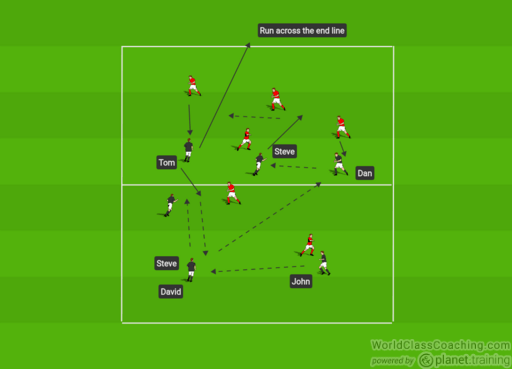
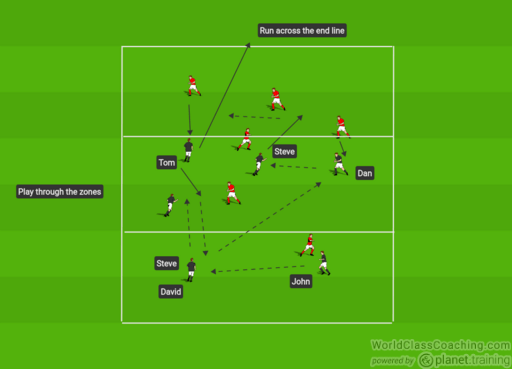

Some Coaching Points
• Awareness of player in possession and player to mark
• Body shape for 1st and 2nd movement
• Change of direction and speed
• Timing of movement
• Tracking runners (body shape prepared)
• Communication
• Recognizing space to run into
By Sean Reed
Former First Team Coach of Championship team Fulham FC. Sean is a UEFA A Coach with a Masters in Sport Coaching. He has over 15 years of experience working in professional football from Academy through to First team in the Premiership and Championship.
Web – www.seanjreed.com
Twitter – @SeanJReed

Build up play into wide areas
By Sean Reed –
Objective
This session focuses on build up play into wide areas to cross and finish, specifically cross-field passes and a combination to create a crossing opportunity and eventually a shot on goal. This session enables players to work on specific aspects of their game.
Set Up – 1st Part
This session takes place in one half of the pitch. It is set up as within Diagram 1, with 2 centre backs or centre midfield players (working on their range of passing) and 2 wide players either side (working on their crossing) and groups of 3 players in around the penalty area working on their movement and finishing.
The first part of the session starts with the 2 deepest players combining to then play a cross-field pass into a wide player, who then plays a pass into one of the attacking players (who start around the penalty spot, coming to the edge of the penalty area), to combine for the deepest wide player to cross the ball in. Meanwhile once the attacking player has played the pass, the 3 players make movements to ensure they cover the near, middle and far post area of the goal.
The second part the 3 attacking players come out, a ball starts with one of the CB (CM) who then plays a pass to one of attacking players. They must then combine with another player before getting a shot on goal. All 3 attacking players get a chance to shoot on goal. See Diagram 2
Progressions
• Time limit for the attacking players to get a shot off on goal (2nd part)
• Vary the type of cross from wide areas
• An offside line introduced (markers)
Set Up – 2nd Part
The next part of the session is the same as the previous session, but a defender is now introduced to defend the cross and the shots on goal. For the shot the players can be caught off side. See Diagram 3.
Progressions
• The attacking player does not have to combine and can attack 1v1
• Introduction of a 2nd defender
Set Up – 3rd Part
This part of the session continues from the last, but within this session when the ball is played into the highest wide player, they will set the ball back to the deepest wide player, who then plays a pass an attacking player and the wide player will make a run to receive in order to cross See Diagram 4.
Progressions
• Change up the combinations into the attacking players (over’s)
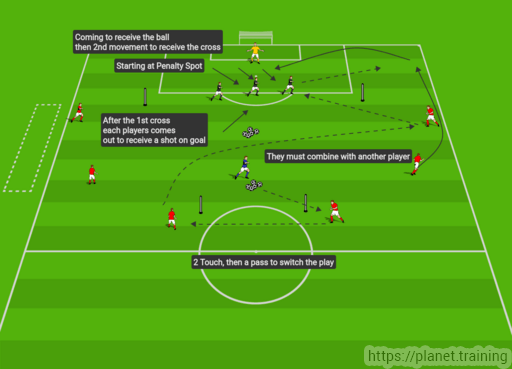
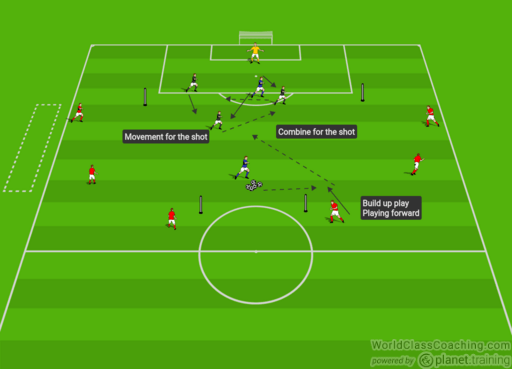
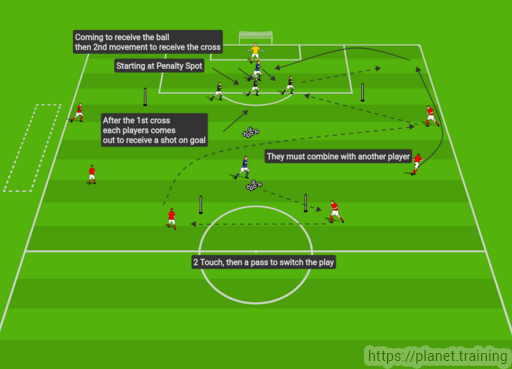
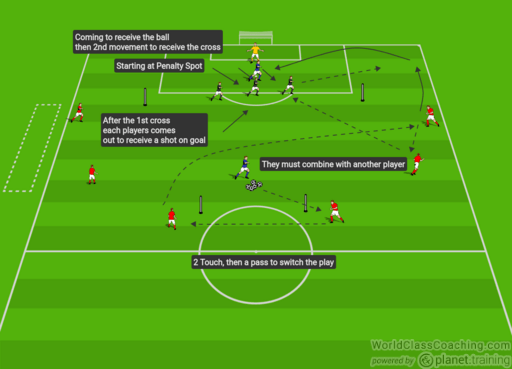
Some Coaching Points
• Tempo of play
• Accuracy and range of passing
• Timing and type of movement to receive the ball
• Distances from players, ball and space
• First touch to set and quality of cross
• Timing of movement to get on the end of the cross, staggered runs, near, middle and far post
• 2nd phase to receive the ball
• Angles of support
• Shot on goal
• Clever combinations
By Sean Reed
Former First Team Coach of Championship team Fulham FC. Sean is a UEFA A Coach with a Masters in Sport Coaching. He has over 15 years of experience working in professional football from Academy through to First team in the Premiership and Championship.
Web – www.seanjreed.com
Twitter – @SeanJReed

Break Out 1v1 Exercise
By Sean Reed –
Objective
This session focuses on players breaking out to create a 1v1 opportunity with the Goalkeeper. Developing from an unopposed practice, to a possession and then into a 1v1 with a recovering defender.
Set Up – 1st Part
This session takes place in the middle of the pitch in around the centre circle. Two teams of 4 or 5 are split and there is a goalkeeper positioned each end of the pitch. See Diagram 1.
The first part of the session is unopposed. Within each team a player is given a number (1-4). There is one ball per team and they are asked to pass and move within the area. At any point the coach will call a number and when the opportunity arises a forward pass into space is played for the number selected to run onto to attack the goal (1v1). The objective for the player attacking is to score with the fewest number of touches and within the quickest time.
Progressions
• Restriction on the number of touches in the passing
• Restriction on the number of touches to goal and specified time limit
• Competitive first player to score wins
Set Up – 2nd Part
The next part of the session involves the teams going into a possession within the middle of the pitch. The coach will specify a number of passes to be made before the breakout can occur (for example 5 passes). If the team defending can win the ball before 5 consecutive passes are made, they then have the chance to make 5 passes and break out. To start they can break out to either goal, but they will be constrained on the amount of time they have to score (i.e. 5 seconds)
Progressions
• Restriction on the number of touches
• Must attack a specific goal
Set Up – 3rd Part
This part of the session continues from the last, but within this session once the ball has been played forward for an attacking player to breakout. One player on the defending team can make a recovery run to prevent the attacking player scoring. See Diagram 3.
Progressions
• As with the previous sessions
• As the game goes on, the coach can allow an extra attacking to player to create a 2v1. Then also, allow another defender to break out to even the teams up
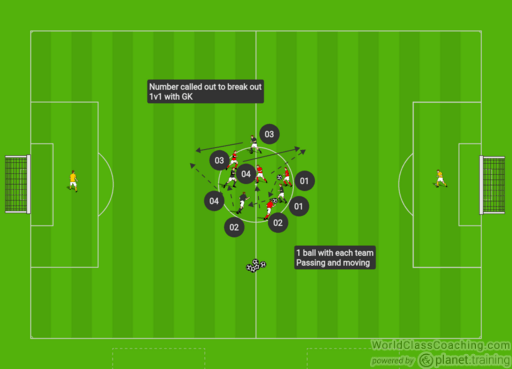
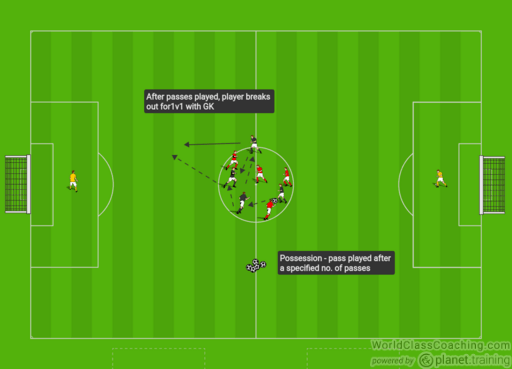
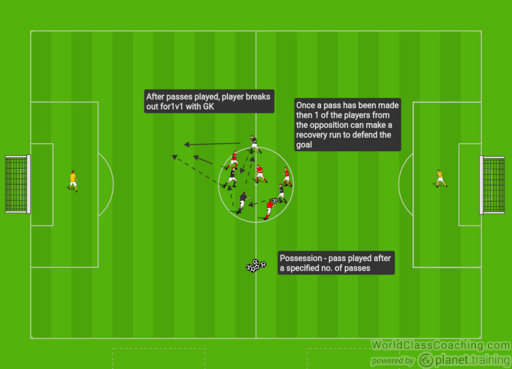
Some Coaching Points
• Tempo of passing
• Angles of movement
• Forward pass into space
• Timing of run, acceleration onto the ball
• First touch into space
• Speed and composure running with the ball (Ball distance allowing the player to run at pace)
• Composure in front of goal
• End product to hit the target
By Sean Reed
Former First Team Coach of Championship team Fulham FC. Sean is a UEFA A Coach with a Masters in Sport Coaching. He has over 15 years of experience working in professional football from Academy through to First team in the Premiership and Championship.
Web – www.seanjreed.com
Twitter – @SeanJReed
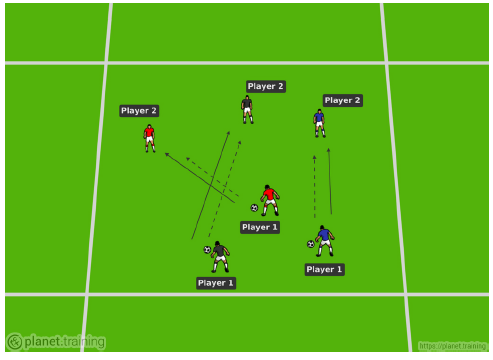
Warm Up Games
By Sean Reed –
Objective
This session can be used as part of the warm up working on quick movements with and without the ball and within a competitive situation. Using games / competitive sessions can be a good way to engage the players at the start of the session.
Set Up – 1st Part
The objective of this part of the session is for the players to work on their quick movement with and without the ball. Taking the ball from the middle area and dribbling the ball back into their own area. The first player to transfer 3 balls back into their area will be the winner.
The area is set up as within Diagram 1. Four players start within their area, with 9 balls in the middle. On the call of the coach the players will run to the middle, collect a ball, dribble the ball back, leave the ball in their respective areas (must stay in there), and then return back to the middle to collect the ball.
The players must keep control of the ball when dribbling with it.
Progressions
• Limit which foot they can use (i.e. right foot only)
• An exercise when they return to their area after each ball (i.e. chest on the ground)
• Travel in a different ways from own area to the middle area (i.e. backwards)
Set Up – 2nd Part
The session is set up as within the previous session. On this 2 balls are removed and there are now only 7 balls in the area. The aim of the game remains the same (first player to get 3 balls into their area). See Diagram 2. Within this game the players can now steal a ball from other players (from their area). This can stop the other players getting 3 balls into their area and it may also be a quick route to get balls back into your own area.
Progressions
• Limit which foot they can use (i.e. right foot only)
• Exercise after they return to their area after each ball (i.e. back on the ground)
Set Up – 3rd Part
As the session evolves a new condition is introduced into Part 3. The rules regarding 3 balls into the players area and stealing from other players continues. Once they have returned a ball to their won area, the players must make a movement around either one of the red cones before claiming a new ball. See Diagram 3.
Progressions
• Different movements between red cones (i.e. must always be facing the middle part of the area / hopping on one foot etc)
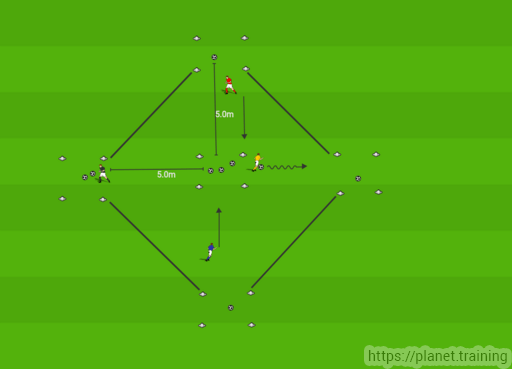
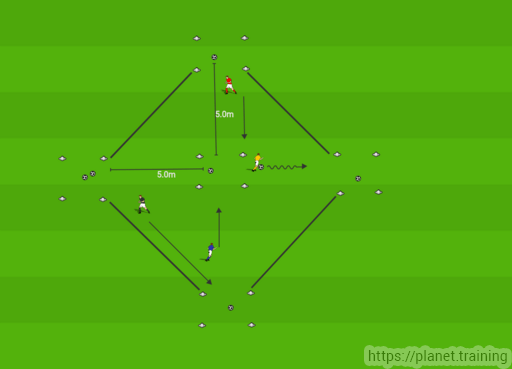
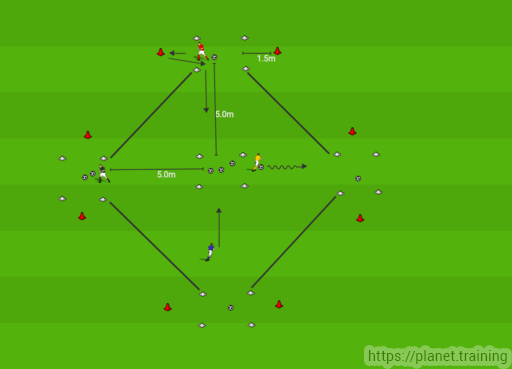
Some Coaching Points
• Speed of movements – foot contact
• First 3 steps (Distance, body shape)
• Deceleration on approach to ball
• Control of the ball between areas
• Awareness of next movement and other players footballs
By Sean Reed
Former First Team Coach of Championship team Fulham FC. Sean is a UEFA A Coach with a Masters in Sport Coaching. He has over 15 years of experience working in professional football from Academy through to First team in the Premiership and Championship.
Web – www.seanjreed.com
Twitter – @SeanJReed
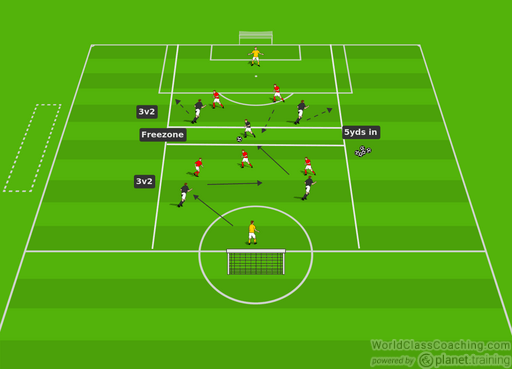
Races with and without the ball
By Sean Reed –
Objective
This session focus’s on putting players into competitive races, which can challenges aspects of movement including their acceleration, deceleration, speed and movement. This session can be used as part of the warm-up.
Set Up – Races without the ball
The session is set up with a middle area (home) with 3 poles, depending on the number of players involved. Each pole will have a colour, which is allocated to each one of the players. Then there is 4 other areas, with the relevant coloured cones making up the area, which the players will be collecting and returning to the home area (placing them on the respective pole). The areas outside the home area can be anything up to 30yds award, with the cones being placed approx 3yds within each other.
The players can only return one cone at a time and the must go round another pole before going out to collect another cone. First player to collect all 4 cones wins. See Diagram 1
Progressions
• Changing the number of poles they must go round before going out to collect a new one
• Activities in-between for example, when the cone is return, must lay on the ground and get up before going out to collect again
Set Up – Races with the ball
The session is set up as within the previous session. On this occasion a ball is introduced, so the player will run with the ball to collect the cone and return back into the area with the ball. See Diagram 2.
Progressions
• Changing the number of poles they must go round before going out to collect a new one
• Activities in-between for example, when the cone is return, must lay on the ground and get up before going out to collect again
• Using only a specific foot (right or left)
Set Up – Races with different movements
The session is set up as within the first session. The players are now required to perform an alternate movement going out to collect the cones (for example – running backwards, jockeying etc). Then they can run forwards when returning back into the middle (home) area. See Diagram 3.
Progressions
• Changing the type of movements when and where
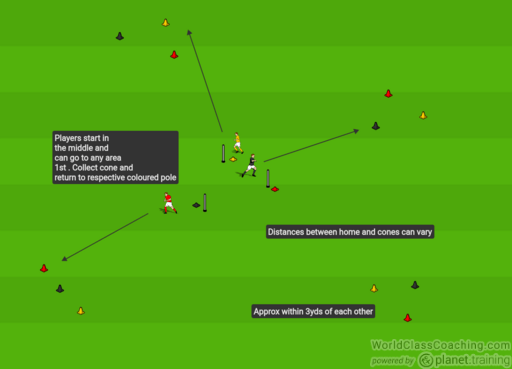
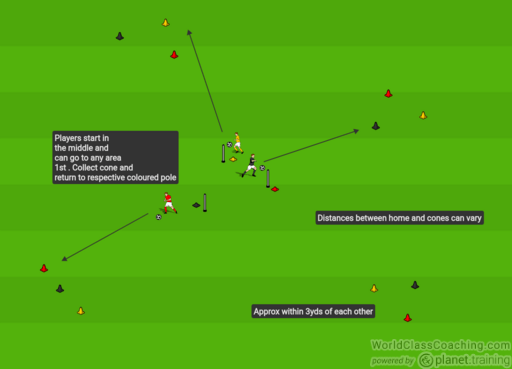
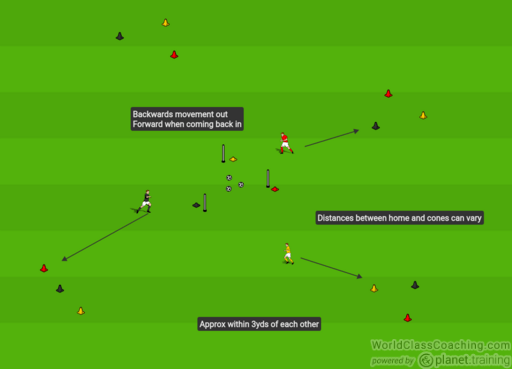
Some Coaching Points
• Awareness of next movement
• Preparing body shape
• Initial movement – first few steps
• Work ethic to achieve good speeds
• Deceleration on approach (Body shape, foot movement)
• Next phase
By Sean Reed
Former First Team Coach of Championship team Fulham FC. Sean is a UEFA A Coach with a Masters in Sport Coaching. He has over 15 years of experience working in professional football from Academy through to First team in the Premiership and Championship.
Web – www.seanjreed.com
Twitter – @SeanJReed

7v4 Transition Exercise
By Sean Reed –
Objective
This session focuses on possession with an overload, managing possession within a small area, working on passing and supporting angles. The team defending are looking to win possession of the ball to encourage a positive transition.
Set Up – Transition
The session is set up in an area 15-20yds x 15-20yds. The teams are split into 3 groups; 4 players (black bibs), 4 players (yellow bibs) and 3 neutral players (red bibs). The players are set up initially as; players in black bibs are the team in possession with support from the players in red bibs and the team in yellow bibs is defending.
The team in possession are positioned with the fours corners of the pitch, whilst the neutral players are positioned with 2 players on the outside of the area, both end and 1 player inside the area. The defending team are free to move anywhere within the area. When the defending team forces a mistake or wins possession the teams switch roles. See Diagram 1
Progressions
• Restrictions on the number of touches
• The neutral players can not pass to one another
• Restriction on the number of touches for neutral players
Set Up – Transition (in & out of the area)
The session is set up as within the previous session. Within this session the team in possession can receive the ball either within the area or outside the area. See Diagram 2. When the team is in possession they are on 2 touches inside the area and only 1 touch when outside the area.
Progressions
• Restrictions on the number of touches inside and outside the area
• Restriction on the number of touches for neutral players
Set Up – Transition with Goals
The session is set up as within the previous session. For this session two goals have been included for the defending team to attack when they win possession. As soon as possession is turn over they are looking to get a shot off into either goal. The team that has lost possession is looking to prevent the team from shooting. See Diagram 3.
Progressions
• Restriction on the number of touches
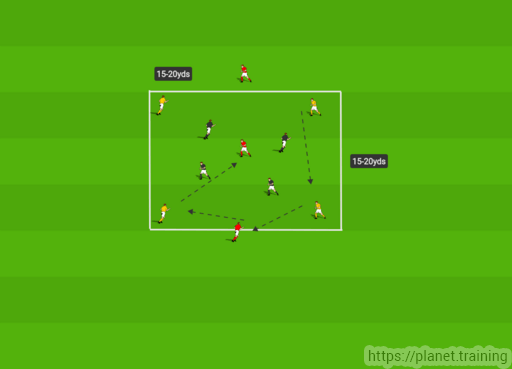
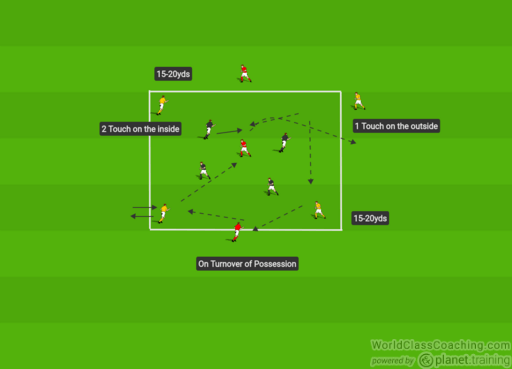
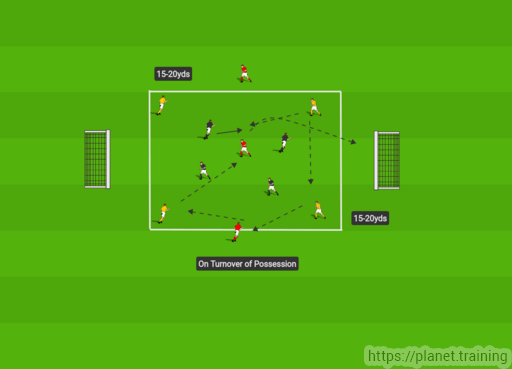
Some Coaching Points
• Movement to receive the ball
• Quality and tempo of play
• Angles of support
• Knowing next movement and pass
• 1st Touch changing the direction of play
• Range of passing to switch the play
• Maintaining good width and distances
• Transition in possession (focus of mindset)
• Transition out of possession (focus of mindset)
By Sean Reed
Former First Team Coach of Championship team Fulham FC. Sean is a UEFA A Coach with a Masters in Sport Coaching. He has over 15 years of experience working in professional football from Academy through to First team in the Premiership and Championship.
Web – www.seanjreed.com
Twitter – @SeanJReed
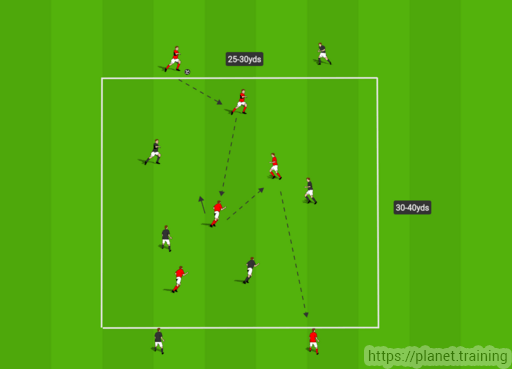
Playing Forward
By Sean Reed –
Objective
For this session we are focusing playing forward and supporting the forward pass.
Set Up
The session is set up within an area approx 30-40 in Length by 25-30 Width. It is 4v4 in the middle with 2 players from each team at each end.
The team in possession can score a goal when the ball is played into one outside player and then worked down to the other outside player, retaining possession of the ball (the player outside is on 1 touch). See Diagram 1
Depending on how long the session is played for, players switch from the outside to the inside.
Progressions
• Restrictions on the number of touches
• The player who plays a pass into the end player cannot receive directly from that player. Another player must receive the ball. See Diagram 2
Set Up – with Goals
The session is set up as within the previous session, but with the inclusion of 2 goals, 1 up each end. The players on the outside are positioned either side of the goal.
A goal is scored when the ball is played to an outside player and then played back into an inside player to score into the goal. The ball must be played by the player receiving the ball immediately into the goal and cannot be passed to someone else (2 touch). See Diagram 3.
Progressions
• Restrictions on the number of touches
• The player who plays a pass into the end player cannot receive directly from that player. Another player must receive the ball.
• 1 touch finish on the inside from the ball received from the outside
• Introduction with 2 goals. Outside players are in the middle and goals either side. The teams have 2 goals to score in. See Diagram 4.

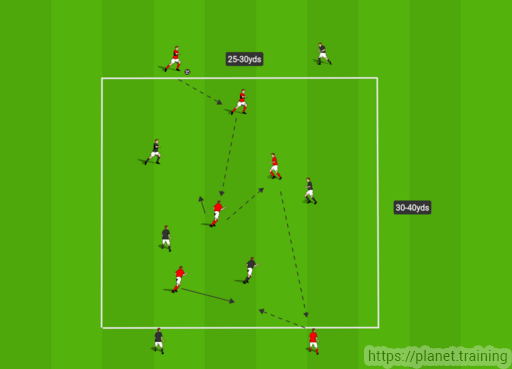
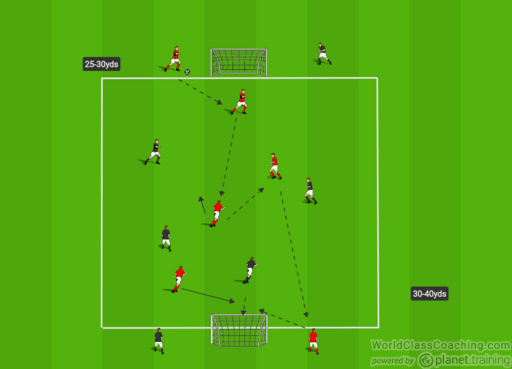
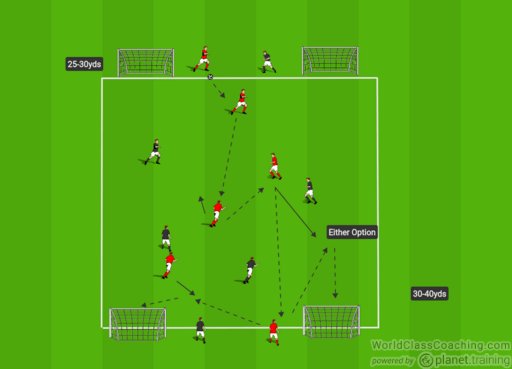
Some Coaching Points
• Movement to receive the ball
• Looking for opportunities to pass forward
• Supporting the ball
• Forward runs
• Timing of movements and creative runs
• Weight of pass
• Control of finish
By Sean Reed
Former First Team Coach of Championship team Fulham FC. Sean is a UEFA A Coach with a Masters in Sport Coaching. He has over 15 years of experience working in professional football from Academy through to First team in the Premiership and Championship.
Web – www.seanjreed.com
Twitter – @SeanJReed
